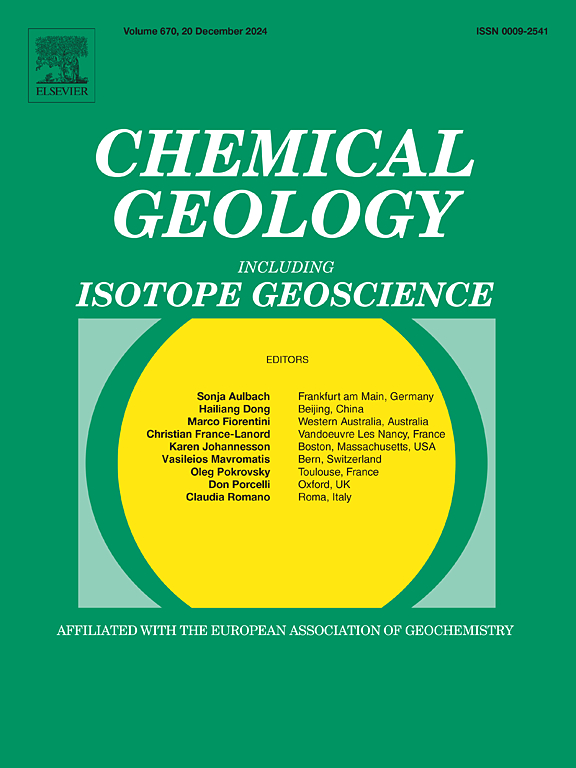Paleoenvironmental changes and nitrogen cycling of the lacustrine systems following the Toarcian Oceanic Anoxic Event in the Sichuan Basin (China): Insights from nitrogen isotopes
IF 3.6
2区 地球科学
Q1 GEOCHEMISTRY & GEOPHYSICS
引用次数: 0
Abstract
The Toarcian Oceanic Anoxic Event (T-OAE) represents a significant disturbance of the Earth's atmosphere-ocean system in the Early Jurassic, and its response in lacustrine systems has been widely studied in recent years. However, the impact of T-OAE on the subsequent environmental changes and nitrogen cycling patterns in lacustrine systems are poorly understood. This study investigated the paleoenvironmental changes following the T-OAE based on elemental geochemistry analyses of organic-rich shales from the Early Jurassic Da'anzhai Member and the Middle Jurassic Lianggaoshan Formation in the Sichuan Basin. The nitrogen cycling during this period was reconstructed drawing on nitrogen isotopes (δ15N) and their correlations with water column conditions. The results indicated that during the deposition of Da'anzhai shale (i.e., T-OAE period), the lacustrine system was dominated by a temperate-humid climate, with frequent oxic-suboxic variations in the water column. The sedimentary environment of the Lianggaoshan shale was similar to that of the Da'anzhai shale, even though there was a brief arid-cold climate during the sedimentary period at the bottom of Lianggaoshan Formation. The nitrogen isotopes of kerogen (δ15Nker) were primarily controlled by the redox conditions of water column, and the silicate-bound inorganic nitrogen isotopes (δ15Nsil) were influenced by combined factors including climate, input of terrestrial clay minerals, and the redox conditions of the bottom water column. These variations in δ15N provided foundations for reconstructing nitrogen cycling under diverse lacustrine environmental conditions. Under the suboxic water column, the occurrence of denitrification and anaerobic ammonium oxidation (anammox) in the chemocline resulted in enrichment of 15N in kerogen. The positive excursion in δ15Nsil was a cumulative effect attributed to the enhanced influx of exogenous illite under temperate-humid climatic conditions, as well as the combined influence of anammox on NH4+ concentrations. In water column with elevated oxygen concentrations, biogeochemical processes, predominantly driven by nitrification, resulted in lighter δ15Nker values, and δ15Nsil, influenced by the low concentration of NH4+ in the bottom water, also exhibited a lighter isotopic signature. The similar geochemical signatures in the Da'anzhai and Lianggaoshan shales implied that the lacustrine system might be susceptible to variations in localized paleoenvironment, and was not completely consistent with the marine system.
四川盆地Toarcian ocean缺氧事件后湖泊系统的古环境变化与氮循环:来自氮同位素的启示
Toarcian Oceanic Anoxic Event (T-OAE)代表了早侏罗世地球大气-海洋系统的一次重大扰动,其在湖泊系统中的响应近年来得到了广泛的研究。然而,T-OAE对湖泊系统后续环境变化和氮循环模式的影响尚不清楚。通过对四川盆地早侏罗世大安寨段和中侏罗世两高山组富有机质页岩元素地球化学分析,探讨了T-OAE后的古环境变化。利用氮同位素(δ15N)及其与水柱条件的相关性重建了这一时期的氮循环。结果表明,在大安寨页岩沉积时期(即T-OAE期),湖相体系以温湿润气候为主,水体氧-亚氧变化频繁。梁高山组沉积期虽有短暂的干冷气候,但其沉积环境与大安寨组相似。干酪根氮同位素(δ15Nker)主要受水柱氧化还原条件控制,硅酸盐结合无机氮同位素(δ15Nsil)受气候、陆相粘土矿物输入和底水柱氧化还原条件等综合因素影响。这些δ15N的变化为重建不同湖泊环境条件下的氮循环提供了依据。在缺氧水柱下,趋化cline中反硝化和厌氧氨氧化(anammox)的发生导致干酪根中15N的富集。δ15Nsil的正偏移是温湿气候条件下外源伊利石流入增强的累积效应,以及厌氧氨氧化对NH4+浓度的综合影响。在高氧水体中,主要由硝化作用驱动的生物地球化学过程使δ15Nker值变轻,而δ15Nsil受底层水体低浓度NH4+的影响也表现出较轻的同位素特征。大安寨页岩和两高山页岩具有相似的地球化学特征,表明其湖相体系可能易受局部古环境变化的影响,与海相体系不完全一致。
本文章由计算机程序翻译,如有差异,请以英文原文为准。
求助全文
约1分钟内获得全文
求助全文
来源期刊

Chemical Geology
地学-地球化学与地球物理
CiteScore
7.20
自引率
10.30%
发文量
374
审稿时长
3.6 months
期刊介绍:
Chemical Geology is an international journal that publishes original research papers on isotopic and elemental geochemistry, geochronology and cosmochemistry.
The Journal focuses on chemical processes in igneous, metamorphic, and sedimentary petrology, low- and high-temperature aqueous solutions, biogeochemistry, the environment and cosmochemistry.
Papers that are field, experimentally, or computationally based are appropriate if they are of broad international interest. The Journal generally does not publish papers that are primarily of regional or local interest, or which are primarily focused on remediation and applied geochemistry.
The Journal also welcomes innovative papers dealing with significant analytical advances that are of wide interest in the community and extend significantly beyond the scope of what would be included in the methods section of a standard research paper.
 求助内容:
求助内容: 应助结果提醒方式:
应助结果提醒方式:


